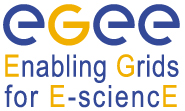Speaker
Describe the activity, tool or service using or enhancing the EGEE infrastructure or results. A high-level description is needed here (Neither a detailed specialist report nor a list of references is required).
The work focuses on an easy to use framework that automates the deployment and management of all EGEE components in sites where a common Grid operating environment must be rapidly setup. The approach is based on the Rocks Toolkit and is supported around the concept of ROLL, an isolated package containing software and configuration files, used to install and configure specific software packages and to create new appliances with little involvement from system administrator.
Describe the added value of the grid for your activity, or the value your tool or service adds for other grid users. This should include the scale of the activity and of the potential user community, and the relevance for other scientific or business applications.
Potential EGEE sites still lack complete solutions for the distribution, installation and configuration of middleware to build managed Grid infrastructures. The EGEE Roll was developed to provide a common operating environment across all the sites of a dispersed European Civil Protection community VO with the automated deployment of the EGEE Grid middleware.
The framework enables site administrators to deploy all the elements types required by the EGEE model such as CE/SE/UI/MON/WNs, tackling the most time-consuming portions of a site installation. The elements are based in Rocks appliances that can be modified to specific configuration needs.
It replaces manual software installation and configuration by an almost fully-automated installation process, guaranteeing interoperability across sites and customisation at any CP site administrative domain to explore the capabilities of Grid in CP applications and to reduce the overall time required for the deployment of a new site.
Report on the impact of the activity, tool or service. This should include a description of how grid technology enabled or enhanced the result, or how you have enabled or enhanced the infrastructure for other users.
The approach proved to be pertinent when developing infrastructures and services for virtual organisations, including software update and user management.
An EGEE Site is created by first bringing up a Point of Presence (pop), which is a frontend server exposed to the outside world, that provides services to allow a controlled site customisation and to incorporate components in the base distribution.
The process requires booting with the Kernel/Boot CD and then selecting the required Base, HPC, Kernel/Boot, Web Server and OS rolls, followed the EGEE roll.
Alternatively a pop may be installed using one or more "Central" pop servers over a wide area network, a process called WAN kickstart that allows a client pop to retrieve Rocks’ Rolls over the Internet, and use these to install itself.
Next, a sequence of configuration screens collects most of the information needed to generate the local configuration files, required to install and configure all the different elements of a site.




